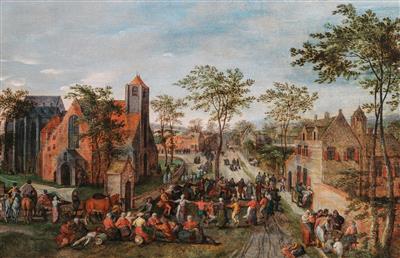Jacob Grimmer

(Antwerp 1525–1590)
A village kermesse,
oil on panel, 38 x 57.5 cm, framed
Provenance:
Private collection, Belgium
The present scene of dancing peasants, supine drunks and squabbling children is an evocative example of the most lively of Jacob Grimmer’s genres of painting – the Village Kermesse. Working in the wake of the great Pieter Brueghel the Elder (1525/30–1569), Grimmer not only was a gifted landscapist, remarkable for the finesse of his colouring and the clarity of his drawing, seen here in the serpentine trees and rustic architecture, but also an inventor of varied and original figure groupings. In the present panel the tumbling and reveling inhabitants seem to be engaged in every diverse manifestation, and almost every conceivable pose, of bucolic life. Elegantly dressed burghers on horseback (to the left) next to a covered wagon, and bending over, inspecting local produce, (on the right) contrast with the more roughly costumed villagers, as may also be seen in another Kermesse panel (monogrammed, dated 1579) conserved the National Gallery in Prague, representing each strata of Flemish society.
An execution date in the 1580s towards the end of Grimmer’s career, would fit both with the figure types, which have been suggested to possibly be the work of Gillis Mostaert (1528–1598), and with his use of the church on one side of the composition and the gables of the houses on the other to provide a linear recession from a typically bird’s eye view, which he also employs in another of his Village Kermesse panels (56 x 82 cm, monogrammed, dated 1589) conserved in the Kunsthalle, Bremen. Describing Grimmer’s compositional tendencies, Reine de Berthier de Sauvigny writes in her monograph of the Bremen Kermesse that ‘the village square is pictorially limited by the characteristic constructions which dominate (such as) the massive gothic church tower’ while the multiplicity of ‘small living scenes around, full of movement, lend a free and frank realism’ – features that Grimmer also masterfully repeats in the present panel.
Esperto: Damian Brenninkmeyer
 Damian Brenninkmeyer
Damian Brenninkmeyer
+43 1 515 60 403
oldmasters@dorotheum.com
08.06.2021 - 16:00
- Prezzo realizzato: **
-
EUR 69.050,-
- Stima:
-
EUR 40.000,- a EUR 60.000,-
Jacob Grimmer
(Antwerp 1525–1590)
A village kermesse,
oil on panel, 38 x 57.5 cm, framed
Provenance:
Private collection, Belgium
The present scene of dancing peasants, supine drunks and squabbling children is an evocative example of the most lively of Jacob Grimmer’s genres of painting – the Village Kermesse. Working in the wake of the great Pieter Brueghel the Elder (1525/30–1569), Grimmer not only was a gifted landscapist, remarkable for the finesse of his colouring and the clarity of his drawing, seen here in the serpentine trees and rustic architecture, but also an inventor of varied and original figure groupings. In the present panel the tumbling and reveling inhabitants seem to be engaged in every diverse manifestation, and almost every conceivable pose, of bucolic life. Elegantly dressed burghers on horseback (to the left) next to a covered wagon, and bending over, inspecting local produce, (on the right) contrast with the more roughly costumed villagers, as may also be seen in another Kermesse panel (monogrammed, dated 1579) conserved the National Gallery in Prague, representing each strata of Flemish society.
An execution date in the 1580s towards the end of Grimmer’s career, would fit both with the figure types, which have been suggested to possibly be the work of Gillis Mostaert (1528–1598), and with his use of the church on one side of the composition and the gables of the houses on the other to provide a linear recession from a typically bird’s eye view, which he also employs in another of his Village Kermesse panels (56 x 82 cm, monogrammed, dated 1589) conserved in the Kunsthalle, Bremen. Describing Grimmer’s compositional tendencies, Reine de Berthier de Sauvigny writes in her monograph of the Bremen Kermesse that ‘the village square is pictorially limited by the characteristic constructions which dominate (such as) the massive gothic church tower’ while the multiplicity of ‘small living scenes around, full of movement, lend a free and frank realism’ – features that Grimmer also masterfully repeats in the present panel.
Esperto: Damian Brenninkmeyer
 Damian Brenninkmeyer
Damian Brenninkmeyer
+43 1 515 60 403
oldmasters@dorotheum.com
|
Hotline dell'acquirente
lun-ven: 10.00 - 17.00
old.masters@dorotheum.at +43 1 515 60 403 |
| Asta: | Dipinti antichi I |
| Tipo d'asta: | Asta in sala con Live Bidding |
| Data: | 08.06.2021 - 16:00 |
| Luogo dell'asta: | Wien | Palais Dorotheum |
| Esposizione: | 29.05. - 08.06.2021 |
** Prezzo d'acquisto comprensivo di tassa di vendita e IVA
Non è più possibile effettuare un ordine di acquisto su Internet. L'asta è in preparazione o è già stata eseguita.
